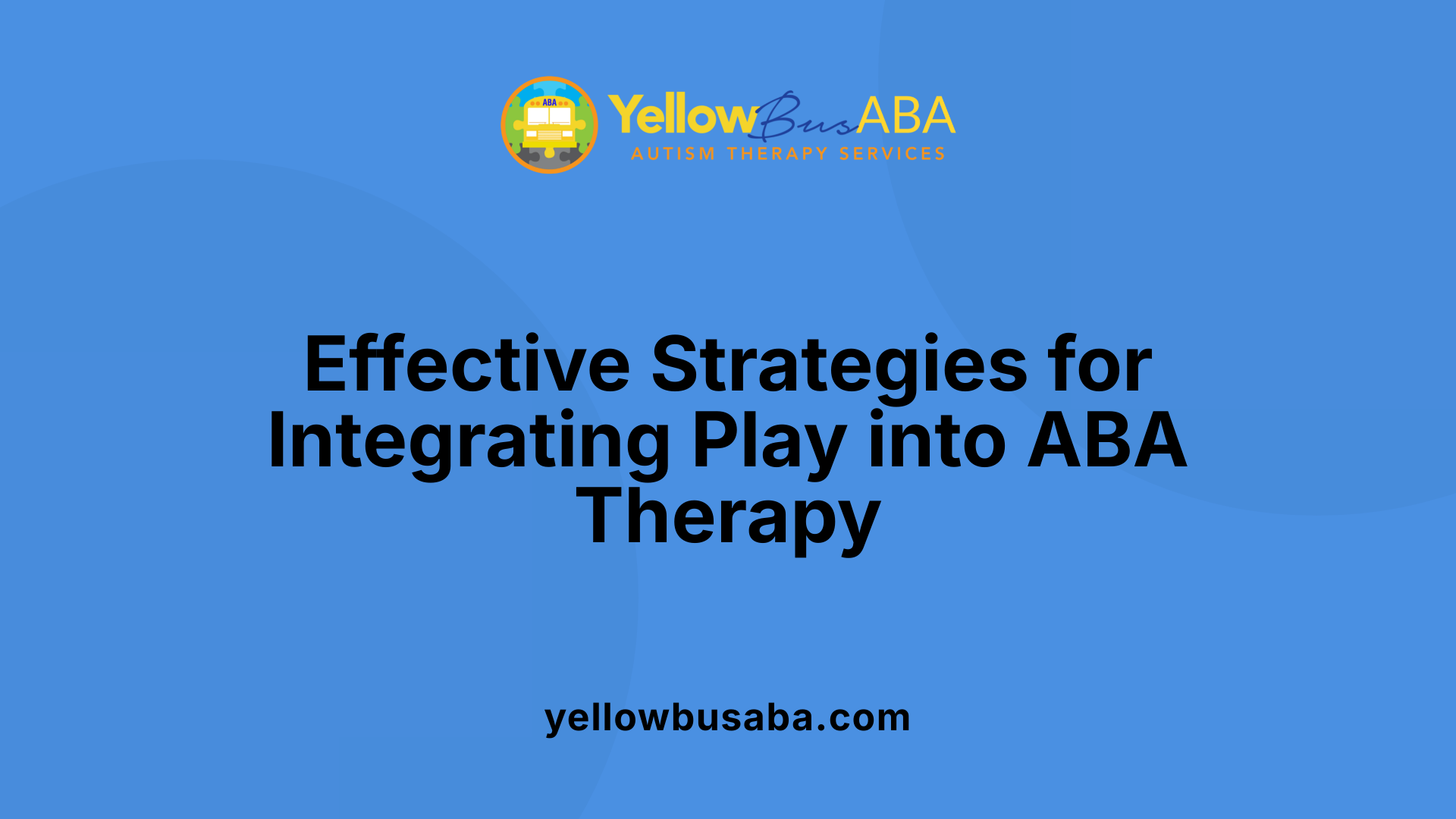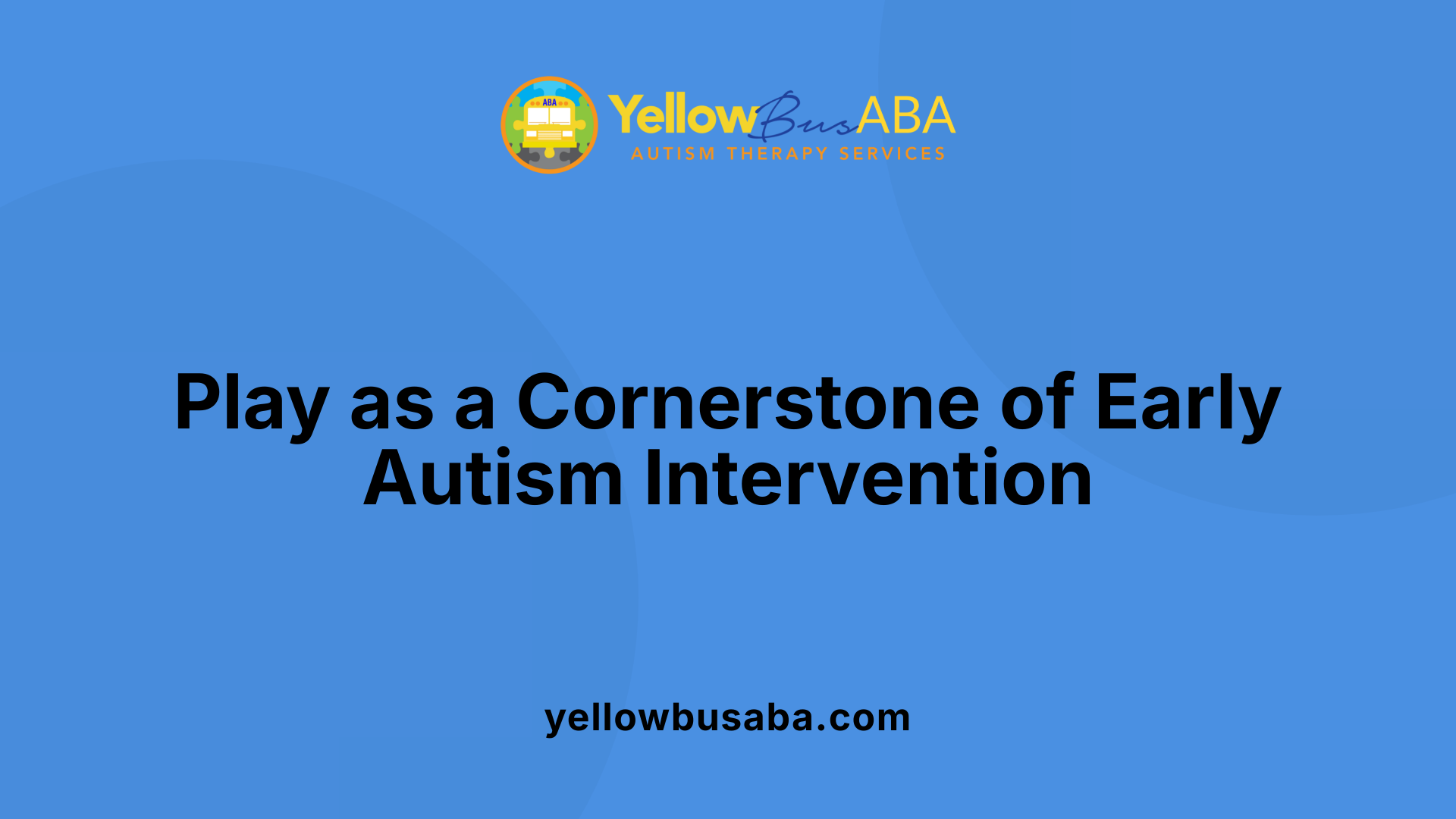The Role of Play in ABA Therapy for Young Children
August 26, 2025
Enhancing Child Development with Play-Based ABA Therapy

Understanding the Power of Play in Early Childhood and Autism Interventions
Play is a fundamental aspect of childhood development, serving as a natural conduit for learning, growth, and emotional connection. Its significance becomes even more pronounced in the context of ABA therapy for children with autism, where play-based strategies are employed to foster essential developmental skills in an engaging and motivating manner.
The Foundations of Play in Child Development and ABA Therapy

What is the role of play in early child development and in ABA therapy for children with autism?
Play is fundamental to early childhood growth, supporting brain development and fostering essential skills across cognitive, social, emotional, and physical domains. It provides children with a safe and engaging way to explore their environment, learn new concepts, and practice interactions.
In the context of ABA therapy for children with autism, play serves as a vital tool to motivate learning and teach new behaviors. It creates a positive, motivating environment where children can develop social skills such as sharing, turn-taking, and cooperation. Play also helps improve communication skills through activities like requesting, responding, and engaging in pretend play.
Therapists use structured, naturalistic, and social play to target specific developmental goals. For example, structured play with toys or activities can focus on requesting or emotional regulation. Naturalistic play integrates learning into everyday routines, following children’s interests, which enhances engagement and skill generalization.
Using open-ended materials, such as loose parts or recycled objects, further boosts development. These materials encourage creativity, problem-solving, and collaboration—helping children experiment, adapt, and learn at their own pace. Such flexible tools are especially effective in personalized ABA programs, allowing therapists to tailor activities to each child’s needs.
Incorporating play into therapy takes advantage of children’s natural curiosity and motivation, making learning enjoyable. It helps develop critical skills like social interaction, communication, emotional regulation, and independence, all of which are central to successful early intervention for children with autism.
Types of Play and Their Therapeutic Significance

What are the different types of play used in ABA therapy?
ABA therapy incorporates various play styles to meet the unique needs of each child. The main types include structured play, naturalistic play, social play, and sensory play. Each serves specific developmental and therapeutic purposes.
Structured play involves specific toys or activities designed to target particular skills. For example, using puzzles to enhance problem-solving or requesting games to improve communication. These activities are goal-oriented, making therapy sessions both engaging and purposeful.
Naturalistic play integrates learning into everyday routines and interests of the child. It encourages spontaneous interaction and explores real-world scenarios, such as pretend cooking or grocery shopping, to develop skills in a familiar context.
Social play aims to foster social skills like sharing, cooperation, and group interaction. Activities like group games or turn-taking exercises allow children to practice social cues and develop confidence in social settings.
Sensory play focuses on calming or stimulating the senses using toys or activities that involve textures, sounds, or visual stimuli. It supports emotional regulation and sensory processing, which are often areas of focus in children with autism.
Goals of each play type in therapy
| Play Type | Primary Goals | Example Activities | Benefits |
|---|---|---|---|
| Structured play | Develop specific skills | Puzzles, requesting games | Enhanced communication, problem-solving |
| Naturalistic play | Promote spontaneous learning | Pretend activities, daily routines | Generalization of skills, motivation |
| Social play | Improve social skills | Group games, turn-taking | Sharing, cooperation, social confidence |
| Sensory play | Regulate emotions, sensory processing | Textured toys, obstacle courses | Emotional regulation, focus |
Examples of play activities for development
- Using board games to teach turn-taking and patience.
- Engaging in pretend play that simulates daily routines like cooking or shopping.
- Participating in group activities to practice sharing and cooperation.
- Exploring textures and sounds through sensory bins or musical instruments.
Incorporating these diverse play activities within ABA therapy creates a rich, motivating environment that supports comprehensive developmental progress. Tailoring activities to each child's interests enhances engagement and facilitates skill mastery across multiple areas.
Strategies for Incorporating Play in ABA Therapy

What strategies are effective for incorporating play into ABA therapy for young children?
In ABA therapy, integrating play is essential for engaging children and making learning enjoyable. Using a variety of play styles, such as structured, naturalistic, and social play, allows therapists to target specific developmental skills like requesting, sharing, and problem-solving.
Therapists are encouraged to follow each child's lead. This means being flexible, offering choices, and customizing activities to match the child's interests. For example, if a child enjoys puzzles, incorporating puzzles into therapy can boost cognitive skills while maintaining motivation.
Engaging children with role-playing, storytelling, turn-taking games, and pretend scenarios helps develop communication, social skills, and emotional regulation naturally. These activities create a playful environment where children feel comfortable trying new behaviors.
Integrating play into daily routines and therapy sessions promotes generalization of skills across settings. Skills learned during play—such as sharing or requesting—are more likely to transfer to real-life situations.
Parents also play a crucial role. By participating in play-based activities at home, they can reinforce skills learned during therapy. Training parents to use play strategies at home extends learning and fosters ongoing development.
Overall, these methods make ABA therapy more engaging and effective, helping children build essential skills while enjoying the process. Evidence shows that incorporating diverse and child-centered play strategies enhances motivation, improves social interactions, and supports long-term growth.
The Critical Role of Play in Early Intervention for Autism

Why is play important in early intervention ABA therapy for children with autism?
Play holds a central place in early intervention ABA therapy because it naturally engages children and makes learning enjoyable. For children with autism, play provides an exciting and motivating way to develop essential skills, including communication, social interaction, and emotional regulation.
Therapists use different types of play—structured, naturalistic, and social—to target specific developmental goals. Structured play involves activities like turn-taking games or requesting tasks that build particular skills. Naturalistic play integrates learning into everyday situations, aligning with the child's interests and routines. Social play emphasizes sharing, cooperating, and engaging with others to strengthen social skills.
Using play in therapy leverages the brain's high plasticity during early years, enabling children to make significant developmental gains. It creates a positive, interactive environment that encourages children to participate actively and learn without resistance.
Furthermore, play supports the generalization of skills, allowing children to practice behaviors across different environments and with different people. Parents are encouraged to participate in play at home, fostering a consistent learning experience. Overall, play makes therapy more effective and enjoyable, empowering children to learn vital skills that serve as the foundation for their future growth and inclusion.
Role Play as a Technique to Enhance Social Skills
What is role play in ABA, and how does it help children with autism?
Role play in ABA therapy involves creating simulated social situations where children can practice responses and behaviors in a safe, controlled setting. It’s a structured activity that replicates real-life interactions, allowing children with autism to explore social roles, improve communication, and learn appropriate social responses.
This method helps children understand social norms and expectations through repetition and guided practice. For instance, a child might practice greeting a peer or requesting help during a pretend store scenario. Because the environment is controlled, children can learn from mistakes without feeling overwhelmed.
Trained therapists or Board Certified Behavior Analysts (BCBAs) carefully design these scenarios to align with each child's developmental needs. This personalized approach ensures that children gain relevant skills that they can generalize to everyday situations.
By engaging in role play, children tend to develop increased confidence and independence when navigating social contexts. They learn how to initiate interactions, respond appropriately, and follow social cues. Overall, role play is a powerful, engaging tool in ABA that supports the development of essential social skills, helping children build meaningful connections and succeed in social environments.
How structured scenarios help children with autism
Structured role play scenarios are intentionally designed to target specific social or communication skills. For example, a scenario might focus on teaching turn-taking, sharing, or asking for assistance. These activities provide clear, predictable steps, making it easier for children to learn and remember behaviors.
Such structured activities also allow therapists to measure progress accurately. They can observe how well a child responds to cues, follows instructions, or demonstrates new skills. The structured nature raises motivation because children often find clear goals and routines engaging.
Repeated practice in these scenarios helps children become more comfortable with social interactions, reducing anxiety and increasing behavioral flexibility. As a result, children are better prepared to manage real-world situations with confidence.
Building confidence and understanding social norms
Engaging in role play allows children to experience social interactions firsthand, which is especially beneficial for children with autism who may struggle with social cues or understanding social rules. Through repeated practice, children learn what behaviors are appropriate in various settings, such as sharing toys or greeting peers.
These activities offer opportunities to receive immediate feedback and encouragement from therapists, reinforcing positive behaviors. As children succeed in these simulated scenarios, their confidence grows, empowering them to apply these skills socially.
In addition, role play helps children internalize social norms like taking turns, making eye contact, and responding politely. By embodying different social roles, children gain a deeper understanding of social expectations, which facilitates smoother transitions into everyday social environments.
Fostering Growth Through Play-Based Interventions
Incorporating play into ABA therapy is not just an enjoyable activity for children; it is a strategic, evidence-based approach to foster meaningful development. By leveraging various types of play—structured, naturalistic, social, and sensory—therapists and parents can target essential skills such as communication, social interaction, emotional regulation, and independence. Engaging children through play enhances motivation, facilitates generalization of skills, and creates a positive environment conducive to learning and growth. Early intervention utilizing play maximizes neuroplasticity during critical developmental periods, paving the way for more robust progress. Ultimately, play stands as a powerful tool in supporting children with autism to reach their full potential and build a foundation for lifelong learning and social engagement.
References
- The Role of Play in ABA Therapy | Behavioral Consulting for Autism
- How Early Intervention ABA Therapy Uses Play To Teach
- Why Play is Essential to ABA Therapy for Children: A Deep Dive
- Understanding the Role of Play in ABA Therapy
- Using Play as a Teaching Tool in ABA Therapy
- Play therapy in children with autism: Its role, implications, and ...
- Applied Behavior Analysis (ABA) | Autism Speaks
- Learning Through Play During Autism Therapy - BlueSprig
- How ABA Therapy Helps Improve Social Skills in Children






